
The Baltic Sea is increasingly turning into a green soup in summer, an alarming symptom of the sea's ecological imbalance. According to the Swedish WWF, the phenomenon has been occurring earlier and earlier over the last 15 years.
Over-fertilisation as the main cause
The main cause of the massive algae bloom is the over-fertilisation of the Baltic Sea. Nutrients such as nitrogen and phosphorus enter the sea from agriculture, sewage treatment plants, industrial plants and private sewage systems and promote excessive algae growth. Despite considerable efforts in recent decades, such as improved sewage treatment plants and stricter regulations for boat toilets, the measures taken so far are not enough. Christer Eriksson, Chairman of the Swedish Boat Association, emphasises: "The algae bloom is not an isolated natural phenomenon, but a direct result of human activity."
Algal blooms are natural in lakes and oceans and are not necessarily bad in themselves, but when they reach unnaturally high levels, they can have devastating consequences for marine life. When the algae die and sink to the bottom, they consume all the available oxygen as they decompose, killing species living on the sea floor such as seagrass, bladderwrack, crustaceans and fish.
However, over-fertilisation is only part of the problem. Industrial fishing, especially large-scale bottom trawling, has drastically reduced the stocks of important fish species such as cod, herring and perch. These fish play a crucial role in the ecosystem, as they normally eat the algae and thus keep their growth in check.
Gustaf Lind, Secretary General of WWF Sweden, warns: "The recurring algal blooms are a clear sign that the Baltic Sea is over-fertilised and under great pressure." The Swedish WWF is campaigning for concrete solutions. The BaltCOP cooperation project focuses on deploying so-called "local action coordinators" to help farmers restore wetlands, renaturalise watercourses and improve habitats in lakes and watercourses. Mats Johansson, expert on eutrophication and project leader at BaltCOP, calls for: "We want the government to make a targeted investment in more local action coordinators together with a ten-year funding plan for wetlands and other measures to reduce eutrophication and improve water quality."
Contact with the algae harbours health risks
The algal bloom also harbours direct health risks for swimmers and other water sports enthusiasts. The blue-green algae, which are actually cyanobacteria, can release toxins that remain in the water for several days. Contact with contaminated water can lead to skin irritation, eye complaints, nausea and diarrhoea.
To avoid health problems caused by the algal bloom:
- Do not swim in discoloured water or in areas with visible algae accumulation.
- Do not allow pets to swim in or drink from such areas.
- Follow the recommendations of local authorities regarding water quality.
- Keep small children away from affected waters.
- Shower thoroughly after swimming.
